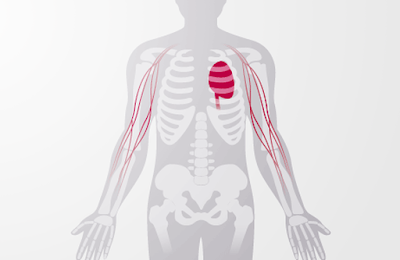By: Ranier Simons, ADAP Blog Guest Contributor
The evolution of HIV treatment has turned HIV into a manageable chronic disease. As such, people living with HIV/AIDS (PLWHA) live longer lives with an expectation of lifespans comparable to those without HIV.[1] PLWHA are now more likely to die from ailments other than HIV. One of those ailments is cardiovascular disease. PLWHA have twice the risk of atherosclerotic cardiovascular disease than the general populace.[2,3] Specifically, the higher risks include heart attack, stroke, heart failure, and pulmonary hypertension.[4] Unfortunately, the reasons for the increased risks are not readily understood.
 |
| Photo Source: AIDSmap |
Traditional risk factors for heart disease, such as high blood pressure and smoking, are the same for PLWHA and the general population. However, ongoing research indicates cardiovascular disease risk factors unique to PLWHA, such as the effects of antiretroviral therapy and biological mechanisms of HIV itself, such as chronic inflammation.[4] Lack of a thorough understanding of the increased risk for cardiovascular disease among PLWHA means there is no established way to battle the issue to improve outcomes. Clinical trials are being conducted to investigate means to treat the problem. One such trial conducted is the REPRIEVE trial.
REPRIEVE stands for ‘Randomized Trial to Prevent Vascular Events in HIV.’ The purpose of the phase 3 trial was to investigate the efficacy of statins in reducing the risk of cardiovascular disease in PLWHA. The idea is to use statins as a primary prevention tool for major adverse cardiovascular events (MACE) in HIV. Statin use was chosen as an intervention because research shows statins lower LDL cholesterol, a significant factor in cardiovascular disease. Additionally, statins positively affect vascular inflammation and immune system activation in PLWHA.[3]
The multinational phase 3 randomized REPRIEVE trial, which included the United States, contained 7769 subjects. Assigned to two groups through computer randomization, the subjects received either oral pitavastatin calcium (at a dose of 4 mg per day) or a placebo. Pitavastatin was chosen because it does not interact with antiretroviral medications. The subjects' inclusion criteria included being 40 to 75 years old, living with HIV, on stable antiretroviral therapy, having no previously known cardiovascular disease, and having no history of statin use in the previous 90 days of entering the study. Another important criterion is that all “had a low-to-moderate risk of atherosclerotic cardiovascular disease, as determined by the score on the American Heart Association and American College of Cardiology 2013 Pooled Cohort Equation risk calculator.”[3]
When studies are done, researchers define a primary outcome. The primary outcome is the most essential occurrence to be examined as a result of applying the intervention in question. For the REPRIEVE, the primary outcome was the occurrence of a MACE. The MACE for this study was not just one issue but considered a composite of the existence of many issues: cardiovascular death; myocardial infarction; hospitalization for unstable angina; stroke; transient ischemic attack (TIA); peripheral arterial ischemia; revascularization of a coronary, carotid, or peripheral artery; or death from an undetermined cause, as measured in a time-to-event analysis.[3]
 |
| Photo Source: New England Journal of Medicine |
In the pitavastatin group, the incidence of MACE was 4.81 per 1000 person-years and 7.32 per 1000-person-years in the placebo group. That equates to a 35% lower MACE incidence in the pitavistatin group.[5] Non-cardiovascular outcomes included muscle and diabetes issues. Myalgia and myopathy occurred in 2.3% of the pitavastatin group and 1.4% of the placebo group. Regarding diabetes, there was a 1.13 incidence rate (5.3%) in the pitavastatin group and a 0.84 incidence rate (4.0%) in the placebo group.[3] This was not surprising since previous research shows that statin use is associated with increased diabetes mellitus as it can increase blood sugar by preventing the body’s proper utilization of insulin.
Additionally, results showed that adverse event rates increased with increasing subgroup risk categories for atherosclerotic cardiovascular disease. However, the number needed to treat (NTT) decreased with rising risk category.[3] This means there is a possible greater benefit of statin use among those who started the study with more baseline cardiovascular risk. NTT is a statistical description indicating how many people need to be treated before a positive outcome is seen. Theoretically, the perfect NTT is 1, meaning that every person treated has a positive outcome. Since the NTT decreased with increasing risk category, more positive outcomes occurred among those with higher levels of diagnosis.
Trials like the REPRIEVE study open the door to investigating the use of other possible statins. Moreover, additional research is imperative since there is currently no established therapeutic or diagnostic paradigm for addressing the increased risk of cardiovascular disease in PLWHA. Without identifying the specific mechanisms contributing to atherosclerotic cardiovascular disease pathology among PLWHA, it is impossible to find or create medical interventions against it.
[1] Hayes, R. (2023, July). Life expectancy for people living with HIV. Retrieved from https://www.aidsmap.com/about-hiv/life-expectancy-people-living-hiv#:~:text=Many%20people%20living%20with%20HIV,adhere%20to%20their%20HIV%20treatment
[2] Boccara, F., Cohen, A. (2016) HIV and heart disease: What cardiologists should know. Revista Espanola De Cardiologia, 69(12), 1126-1130. DOI: 10.1016/j.rec.2016.05.032
[3] Grinspoon, S. K., Fitch, K. V., Zanni, M. V., Fichtenbaum, C. J., Umbleja, T., Aberg, J. A., … Douglas, P. S. (2023). Pitavastatin to Prevent Cardiovascular Disease in HIV Infection. New England Journal of Medicine, 389(8), 687–699. doi:10.1056/NEJMoa2304146
[4] Feinstein, M. J. (09 2022). HIV, Subclinical Cardiovascular Disease, and Clinical Progression: Insights From Immunologic Heterogeneity. JAMA, 328(10), 931–932. doi:10.1001/jama.2022.15226
[5] Susman, E. (2023, July 24). Statin reduced risk of heart disease in people with HIV. Retrieved from https://www.medpagetoday.com/meetingcoverage/ias/105613
[6] Lerner, A. M., Eisinger, R. W., & Fauci, A. S. (2020). Comorbidities in Persons With HIV: The Lingering Challenge. JAMA, 323(1), 19–20. https://doi.org/10.1001/jama.2019.19775
[7] Mulcahy, L. (2023, July 27). Menopause may start earlier for aging women with HIV. Retrieved from https://www.webmd.com/hiv-aids/news/20230627/menopause-may-start-earlier-aging-women-hiv
Disclaimer: Guest blogs do not necessarily reflect the views of the ADAP Advocacy Association, but rather they provide a neutral platform whereby the author serves to promote open, honest discussion about public health-related issues and updates.

No comments:
Post a Comment